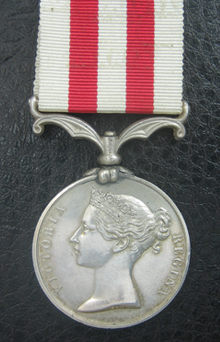
INDIAN MUTINY 1857, NO CLASP ‘LIEUT. J. D. VALLANCE, 40TH. MADRAS N.I.’
John Dunscomb Vallance was born at Woolborough, Devon, on 3 September 1833 and was commissioned Ensign in the 40th Madras Native Infantry on 12 December 1849. He was promoted Lieutenant on 30 November 1855, and served during the Great Sepoy Mutiny with the 40th Native Infantry in the district of Jumblepore from the end of 1857 to March 1858.
‘During this period he was present with the force which stormed and opened the Pass of Jurgotty and was also in all subsequent operations undertaken against the Jumblepore rebels by the late Major Bates. Subsequently commanded a detachment of 40th Regiment against insurgents in the Barra Basahar Hills, in March 1858 was present with a detachment of Jumhlepore Sebundy Levy in an attack on a rebel stronghold in the Zemindary of Jhoberra. From April 1858 to July following commanded a detachment consisting of details from the Shekawati Battalion and Sebundy Levy stationed for the protection of the Chandepore Frontier. During that period was constantly employed in the successful attacks on the rebel strongholds, subsequently during the same and next year was frequently employed in operations against the rebels. In December 1859 commanded a strong detachment of the late Sebundy Levy against a large number of rebels and mutineers under Rajah Soonder Rai at Hullunder. At the later end of 1859 proceeded in command of the Sebundy Levy against insurgents in the Zemindary of Kiereah.’ (Indian Mutiny Medal Roll, Jumblepore Sebundy Levy, refers).
Freedom Movement in Sambalpur, by C. Mishra, gives a further account of the recipient, both during the Mutiny, and in the years that immediately followed:
‘The second phase of Surendra Sai’s war against the British began in 1857 when the great explosion occurred and it convulsed the whole country. The Raja of Bamra was suspected and was reminded of the fate of the Raja of Angul who was imprisoned and his estate confiscated for his rebellious conduct. Accordingly, Captain Woodbridge, Lieutenant Vallance and Captain Sweeny were sent to Sambalpur to meet the situation.
Major Wyndham opened the Dak road to Midnapore through the territory of the Raja of Bamrah. Captain Knocker and Lieutenant Vallance hunted down the rebels in all directions. All these measures being taken for the security of the district three central posts for regular troops and eleven subordinate outposts for the men of the Ramgarh Battalion and the newly raised Sebundies were established.
Accordingly on the night of 6 November 1860, Lieutenant C. B. Smith, Assistant Commissioner, with a party of armed Beldars from Raipur and Lieutenant Vallance in command of a detachment of Samhalpur Sebundy Levy numbering in all two hundred and twenty men, proceeded to Manikgarh EiIt. After detaching a party to hold in check and cut off the retreat of the rebels by Sundara Pass, Lieutenants Smith and Vallance made directly for Tirsola, a village on the Jonk River having a stone breast work thrown across its road by the rebels. They however did not stand to defend it and followed a policy of retreat. In their hurried flight they left several herd of cattle which were captured by Lieutenants Smith and Vallance. Subsequently, the rebels about 150 in number took position in a valley near Manikgarh. It was protected in the front by two breast works of “considerable strength”. It was so constructed as not easily to be turned from either flank.
On 9 November 1860 Lieutenants Smith and Vallance divided their force into three parties; one to protect their camp, one sent in advance to watch the breast work from the front and the third to attack the rebels under Lieutenants Smith and Vallance. The party ascended the high and precipitous Hill of Manikgarh and attacked the rebels from the rear. The rebels gave a dogged defence but could not withstand for a longer time. They fled to Junagarh Ghat. Three of the villages built by the rebels behind their defences were set on fire and destroyed and some more cattle were captured. In order to implement the decision regarding the precautionary measures to be taken by the Raja of Khariar, Major Forster left Lieutenant Vallance as ex-officio Assistant Commissioner of Sambalpur, with a party of Sebundies to superintend the work in anticipation to the approval of the Governor General. Major Foster commended the services of Lieutenant Smith and Lieutenant Valance to the authority for recognition.’
Vallance was promoted Captain on 20 August 1863, and, after a period as District Superintendent of Police in the Central Provinces, was advanced Major on 12 December 1869. He retired in March 1873.
Condition , claw refitted, otherwise GVF . Sold with copied research. Ex Spink 1977.